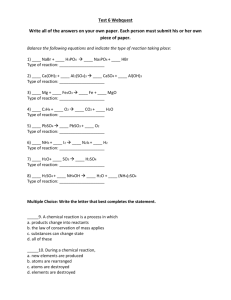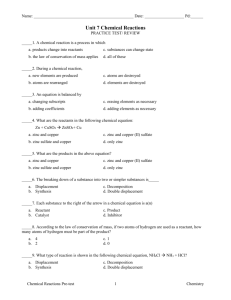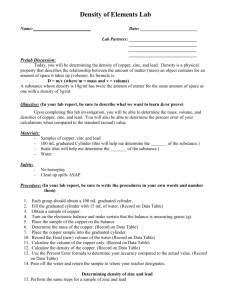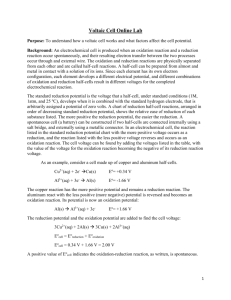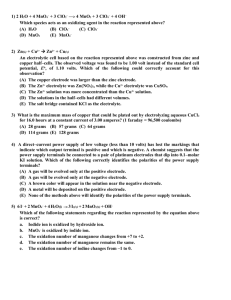Experiment 8: Electrochemistry
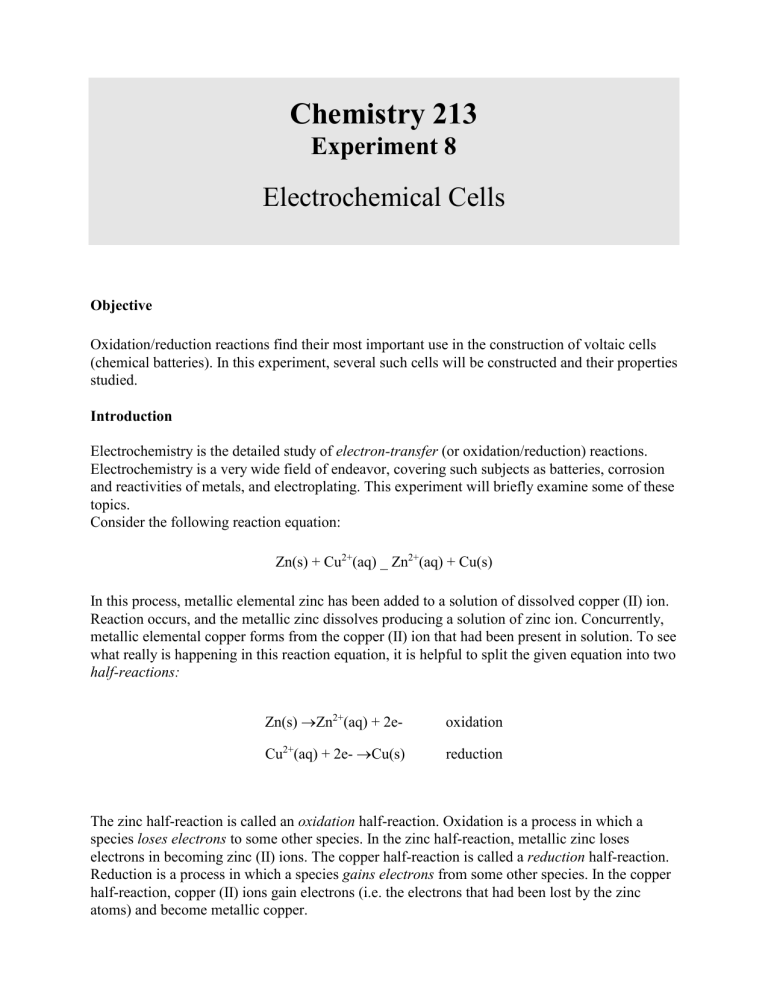
Chemistry 213
Experiment 8
Electrochemical Cells
Objective
Oxidation/reduction reactions find their most important use in the construction of voltaic cells
(chemical batteries). In this experiment, several such cells will be constructed and their properties studied.
Introduction
Electrochemistry is the detailed study of electron-transfer (or oxidation/reduction) reactions.
Electrochemistry is a very wide field of endeavor, covering such subjects as batteries, corrosion and reactivities of metals, and electroplating. This experiment will briefly examine some of these topics.
Consider the following reaction equation:
Zn(s) + Cu
2+
(aq) _ Zn
2+
(aq) + Cu(s)
In this process, metallic elemental zinc has been added to a solution of dissolved copper (II) ion.
Reaction occurs, and the metallic zinc dissolves producing a solution of zinc ion. Concurrently, metallic elemental copper forms from the copper (II) ion that had been present in solution. To see what really is happening in this reaction equation, it is helpful to split the given equation into two half-reactions:
Zn(s)
Zn
2+
(aq) + 2e-
Cu
2+
(aq) + 2e-
Cu(s) oxidation reduction
The zinc half-reaction is called an oxidation half-reaction. Oxidation is a process in which a species loses electrons to some other species. In the zinc half-reaction, metallic zinc loses electrons in becoming zinc (II) ions. The copper half-reaction is called a reduction half-reaction.
Reduction is a process in which a species gains electrons from some other species. In the copper half-reaction, copper (II) ions gain electrons (i.e. the electrons that had been lost by the zinc atoms) and become metallic copper.
In the zinc/copper reaction, metallic zinc has replaced copper (II) ion from a solution. This has happened because metallic zinc is more reactive than metallic copper, and zinc is more likely to be found combined in a compound rather than as the free elemental metal.
The common metallic elements have been investigated for their relative reactivities and have been arranged into what is called the electromotive series.
Electromotive Series:
K, Na, Ba, Ca, Mg ,Al, Mn, Zn, Cd, Fe, Co, Ni, Sn, Pb, H, Sb, Bi, As, Cu, Hg, Ag, Pt, Au
The more reactive elements are at the left of this series, and the elements become progressively less reactive moving toward the right of the series. For example, you will notice that zinc comes considerably before copper in the series, showing that zinc is more reactive than copper.
Notice that H appears in the series. Metals to the left of H are capable of replacing hydrogen ion
(H
+
) from acids, with evolution of gaseous elemental hydrogen (H
2
). In fact, the first four elements of the series are so reactive that they will even replace hydrogen from pure cold water.
Elements in the series that come to the right of H will not replace hydrogen from acids and will consequently generally not dissolve in acids. You will note that the elements at the far right side of the series include the so-called noble metals: silver, platinum, and gold. These metals are used in jewelry because they have such low reactivities and can maintain a shiny, attractive appearance. In addition to hydrogen, an element at the left of the electromotive series can replace any element to its right
As shown above, if we place a strip of zinc in Cu
2+
solution, we will see immediate evidence of a chemical reaction. The zinc begins to dissolve, and a deposit of metallic copper, Cu, appears on the zinc strip. If we place a strip of Cu in Zn
2+
solution, we will observe no evidence of a chemical reaction. Thus, we may conclude that Cu
2+
ion has a greater tendency to accept electrons from Zn than Zn
2+
ion does to accept electrons from Cu. In other words, Cu
2+
ion has a greater reduction potential than Zn 2+ ion. The following table ranks selected metal ions by standard reduction potentials, determine under standard conditions: 25 o
C, 1 atmospheric pressure
(1 atm), and 1 M ion concentration. The reference point for reduction potentials (0.000 V) has been assigned to hydrogen ions. Table 1 shows that Cu
2+
ions have a greater reduction potential than Zn
2+
ion, as we concluded from the experiment described previously.
Table 1: Selected Standard Reduction Potentials for Half-Reactions
Reduction Half-Reaction
Au
3+
(aq) + 3e
Au (s)
Pt
2+
(aq) + 2e
Pt (s)
Ag
+
(aq) + e
Ag (s)
Cu
2+
(aq) + 2e
Cu (s)
2H
+
(aq) + 2e
H
2
(s)
Pb
2+
(aq) + 2e
Pb (s)
Sn
2+
(aq) + 2e
Sn (s)
Ni
2+
(aq) + 2e
Ni (s)
Fe
2+
(aq) + 2e
Fe (s)
Zn
2+
(aq) + 2e
Mg (s)
E o red
, V
+1.50
+1.20
+0.80
+0.34
0.000
-0.13
-0.14
-0.26
-0.44
-0.76
Al 3+ (aq) + 3e
Al (s)
Mg
2+
(aq) + 2e
Mg (s)
Na
+
(aq) + e
Na (s)
-1.66
-2.37
-2.71
While the fact that a reactive metal can replace a less reactive metal from its compounds might be interesting in itself, there is much more implied by the electromotive series. In the zinc/copper reaction discussed at the beginning of this introduction, we considered putting a piece of metallic zinc into direct contact with a solution of copper (II) ion so that electrons could flow directly from zinc atoms to copper ions. A far more useful version of this same experiment would be to set up the reaction so that the zinc metal and copper(II) ion solution are physically separate from one another (in separate beakers, for example) but are connected electrically by a conducting wire. (See Figure) Since the reaction that occurs is a transfer of electrons, this can now occur through the wire, thereby producing an electrical current. We could place a motor or light bulb along the wire joining the zinc/copper beakers and make use of the electrical current produced by the reaction. We have constructed a battery (or voltaic cell) consisting of a zinc half-cell and a copper half-cell. A second connection will have to be made between the two beakers to complete the electrical circuit, however.
Figure 1 : Copper zinc voltaic cell
In common practice, a glass tube containing a nonreactive salt solution is used to do this (a salt bridge), or alternatively a porous porcelain cup is used to contain one half-reaction, with the porcelain cup then being placed in a beaker containing the second ha1f-reaction.
Reactions of voltaic cells are exergonic. They take place with the release of energy. This energy can be put to use if the cell is set up correctly.
In this experiment, you will examine the relative reactivity of some metals and determine a small portion of the electromotive series. You will also set up several batteries and measure the voltage delivered by the cells.
Apparatus/Reagents Required
Equipment for voltaic cells (beakers, salt bridge, voltmeter), 1 M sulfuric acid, 1 M magnesium sulfate, 1 M copper(II) sulfate, 1 M sodium sulfate, 1 M zinc sulfate, 0.1 M copper sulfate, 0.1 M zinc sulfate, small strips of metallic zinc and copper, magnesium turnings, 24-well plate, 4-inch strips of magnesium, copper, and zinc metals.
Experimental Procedure
A. The Electromotive Series
In separate wells of the 24-well test plate, add 10 drops of solutions of one of the following: 1 M sulfuric acid, 1 M magnesium sulfate. 1 M copper(II) sulfate, 1 M sodium sulfate, and 1 M zinc sulfate. Place a small strip of metallic zinc in each well so that the metal is partially covered by the solution in the test plate. Observe closely to see if any chemical reactions take place.
Allow the solutions to stand for about 15 minutes. Examine the zinc strips for evidence of reaction, both during the 15-minute waiting period and after removing. Determine which ionic species zinc is capable of replacing from solution and write equations for the reactions that take place.
Repeat the process using new 10-drop samples of the same solutions, but substituting first copper and then magnesium in place of the zinc metal.
On the basis of your results, arrange the following elements in order of their activity from highest to lowest: H, Mg, Cu, Zn, Na.
B. Voltaic Cells
Using strips of copper, zinc, and magnesium metals as electrodes, and solutions of the sulfates of these metals, you will set up three voltaic cells, and will measure the cell potentials (voltages).
The following procedure is described in terms of copper/zinc voltaic cells. You will also set up copper/magnesium and zinc/magnesium voltaic cells.
Obtain a salt bridge from your instructor. Add 25 mL of 1 M CuS0
4
to a 100-mL beaker. Obtain a
4-inch strip of copper metal and clean it with sandpaper. Place the copper metal strip into the beaker containing the copper sulfate solution to serve as an electrode.
Add 25 mL of 1 M ZnS0
4
to another beaker. Obtain a 4-inch strip of zinc metal and clean it with sandpaper. Place the zinc metal strip into the porous cup containing the zinc sulfate solution to serve as an electrode.
Insert the salt bridge so that one leg is submerged in each beaker.
Connect one lead of the voltmeter to the copper strip, and the other lead of the voltmeter to the zinc strip. Allow the cell to stand until the voltage reading on the voltmeter has stabilized, then record the highest voltage obtained.
Using the table of standard reduction potentials in your textbook, calculate the standard potential
for the copper/zinc voltaic cell. Calculate the % difference between your experimentally determined voltage and the standard voltage.
Using the same method as discussed for the copper/zinc cell, construct copper/magnesium and zinc/magnesium cells and measure their potentials. Calculate the standard cell potential for both of these cells, and the % difference between your experimental voltage and the standard voltage.
C. Effect of Concentration on Cell Potential
Prepare a copper/zinc voltaic cell as in Part B, using 1 M ZnS0
4
solution as before, but replace the 1 M CuS0
4
solution with 0.1 M CuS0
4
solution. Measure the voltage of the cell. How does the decrease in concentration of Cu
2+
ion affect the voltage of the cell? Why?
Prepare a copper/zinc voltaic cell as in Part B, using 1 M CuS0
4
solution as before, but replace the 1 M ZnS0
4
solution with 0.1 M ZnS0
4
solution. Measure the voltage of the cell. Does the decrease in concentration of Zn
2+
ion affect the voltage measured? Why?
Experiment 8: Electrochemistry
Data Sheet
Names ____________________ Date __________________
A. The Electromotive Series
Metal Solution
Zn 1 M H
2
SO
4
1 M MgSO
4
1 M CuSO
4
1 M Na
2
SO
4
1 M ZnSO
4
Observation Chemical Equation for Reaction
Cu 1 M H
2
SO
4
1 M MgSO
4
1 M CuSO
4
1 M Na
2
SO
4
1 M ZnSO
4
Mg 1 M H
2
SO
4
1 M MgSO
4
1 M CuSO
4
1 M Na
2
SO
4
1 M ZnSO
4
On the basis of your results, arrange the elements you tested (H, Mg, Cu, Zn, Na) in order of their activity from highest to lowest. Are your results consistent with the electromotive series and the standard reduction potentials given in table 1?
B. Voltaic Cells
1. Copper zinc voltaic cell
Oxidation half-reaction __________________________________________
Reduction half-reaction __________________________________________
Net reaction
Anode
__________________________________________
__________________________________________
Cathode __________________________________________
Experimental cell potential __________________________________________
Calculated standard cell potential ____________________________________
% difference __________________________________________
2.
Copper magnesium voltaic cell
Oxidation half-reaction __________________________________________
Reduction half-reaction __________________________________________
Net reaction
Anode
__________________________________________
__________________________________________
Cathode __________________________________________
Experimental cell potential __________________________________________
Calculated standard cell potential ____________________________________
% difference __________________________________________
3.
Zinc magnesium voltaic cell
Oxidation half-reaction __________________________________________
Reduction half-reaction __________________________________________
Net reaction
Anode
__________________________________________
__________________________________________
Cathode __________________________________________
Experimental cell potential __________________________________________
Calculated standard cell potential ____________________________________
% difference __________________________________________
C. Effect of Concentration on Cell Potential
1. Copper zinc voltaic cell (0.1 M CuS0
4 and 1 M ZnS0
4
)
Net reaction __________________________________________
Experimental cell potential __________________________________________
Compare the experimental cell potential with that of the copper zinc voltaic cell constructed in
B-1. How does the decrease in concentration of Cu
2+
ion affect the voltage of the cell? Why?
2.
Copper zinc voltaic cell (1 M CuS0
4 and 0.1 M ZnS0
4
)
Net reaction __________________________________________
Experimental cell potential __________________________________________
Compare the experimental cell potential with that of the copper zinc voltaic cell constructed in
B-1. How does the decrease in concentration of Zn
2+
ion affect the voltage of the cell? Why?
Experiment 8: Electrochemistry
Name ____________________
Section___________________
Date_____________________
Pre Laboratory Assignment
1.
What is the purpose of this experiment?
2.
Rank the following metals be ease of oxidation, from easiest to hardest using the electromotive series and the standard reduction potentials given in Table 1: copper, aluminum, iron, and silver.
3.
An aluminum strip is place in CuSO
4
solution. Would you expect a spontaneous reaction to occur, based on the net potential? If the answer is “yes”, write a chemical equation that describes the observations.
4.
Answer the following questions regarding the following electrochemical cell:
2Al (s) + 3Ni
2+
(aq)
2Al
3+
(aq) + 3Ni (s)
(1) Write the reduction and oxidation half-equations for the cell.
(2) Sketch the electrochemical cell. Identify the components of the cell as in Figure 1.
(3) Calculate the expected standard cell potential for the cell using the standard reduction potentials listed in Table 1.
